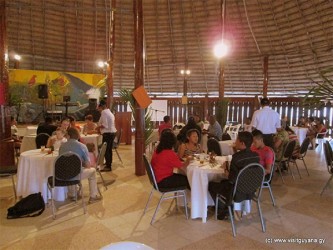Historic occurrences are often known to have small beginnings. That may well be the case with Tuma Sàlà, which, according to shareholder Michael Patterson, is the country’s first Amerindian restaurant.
An Arawak with a passionate interest in Amerindian culture, Patterson told Stabroek Business earlier this week that while Tuma Sàlà is “a business venture” the owners are not insensitive to its ground-breaking significance. It is, Patterson says, as much a statement about elements of the Amerindian way of life as it is a business challenge for the group of investors who have pumped their own money into the business.
Tuma Sàlà comes from the Patamona language and literally means ‘come let us eat.’ The trading name, however, may not convey the fullest significance of the establishment. Patterson sees Tuma Sàlà as symbolizing the bringing of other elements of the Amerindian way of life into an urban setting. The Umana Yana, Guyana’s principal reception hall may have served for decades as the most visible monument to our Amerindian heritage. But Patterson believes Tuma Sàlà’s significance holds a poignancy that demands a different kind of attention.

Inside the modest premises on Middleton Street in Campbellville there is a display of Amerindian craft. Tuma Sàlà will serve as an urban outlet for Amerindian craft which Patterson says will be acquired “on consignment” from individuals and groups as a means of helping them find markets for what they produce. The new establishment will also host cultural occasions to celebrate important Amerindian milestones.
Patterson is hoping that the restaurant can begin to make its earliest mark during this month’s Mashramani celebrations and during Amerindian Heritage Month in September.
Inside, Tuma Sàlà has a modest, even ordinary appearance. Modest is just what it is, Patterson says. The difficulty associated with its creation is reflected in the fact that up until a few days before the launch at the Umana Yana, the investors were still to secure adequate business premises. Even now, there are questions about expansion with answers which, in themselves, raise other questions about financing investment in growth.
For Patterson, however, the challenges associated with the growth of what he says has been a dream for much of his life are not about to dim his enthusiasm. Other issues are competing for his attention; like the need to maintain a high standard of service and the issues associated with offering patrons Tuma Sàlà’s advertised ‘wild meat’ fare while complying with the conservation and environmental strictures associated with the acquisition of the popular meats like deer, labba and wild cow. He explains that since hunting is seasonal there will have to be some amount of storage. Part of Tuma Sàlà’s marketing challenge has to do with the need to further popularise indigenous food and drink. He believes that the effort will be aided by the fact that ‘wild meat’ already possesses a track record among coastlanders. Amerindian drinks, some of which have also become known through displays at events like GuyExpo, are also available at Tuma Sàlà.
Patterson is not indifferent to the importance of making a commercial success of the Tuma Sàlà. The investors, are, however, prepared to exercise a measure of patience knowing that their venture holds a significance that is as much about laying down a historic marker as it is about creating a new business venture.





